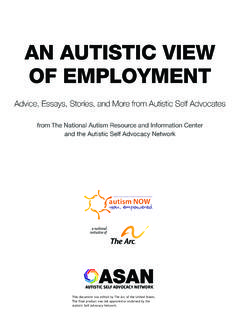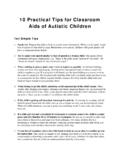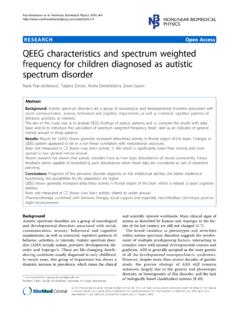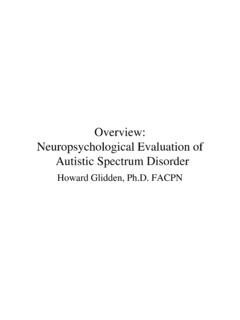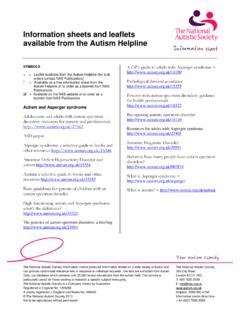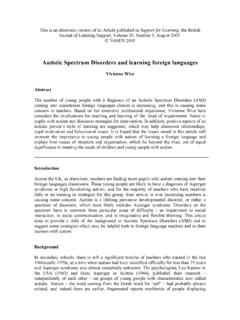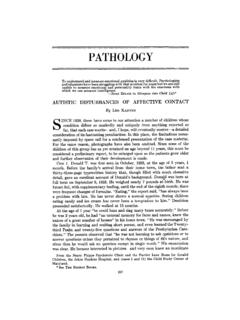Transcription of A One-Year Prospective Follow-Up Study of a DIR/Floortime ...
1 1184 J Med Assoc Thai Vol. 95 No. 9 2012 Correspondence to:Pajareya K, Department of Rehabilitation Medicine, Srisanwan Building, Faculty of Medicine Siriraj Hospital, Mahidol University, Bangkok 10700, : 0-2419-7508E-mail: Med Assoc Thai 2012; 95 (9): 1184-93 Full text. e-Journal: One-Year Prospective Follow-Up Study of a DIR/Floortime Parent Training Intervention for Pre-School Children with Autistic Spectrum DisordersKingkaew Pajareya MD*,Kaewta Nopmaneejumruslers MD** Department of Rehabilitation Medicine, Srisanwan Building, Faculty of Medicine Siriraj Hospital, Mahidol University, Bangkok, Thailand** National Institute for Child and Family Development, Mahidol University, Bangkok, ThailandObjective.
2 Determine the results of 1- year Developmental, Individual-Difference, Relationship-Based (DIR)/Floortime parent training in developmental stimulation of children with autistic spectrum disorder (ASD). Material and Method: Thirty-four, two to six years old children with ASD participated. Parents were encouraged to deliver 1:1 interaction according to their child s developmental level, as they were modeled and coached. Pre-post videotapes were rated by blinded : Thirty-one families completed the present Study . The data showed that adding home-base DIR/Floortime intervention at the average hours/week for one year could help 47% of the children to make good improvement ( Functional Development Level, FDLs or more), with 23% making fair progression (1 FDL), and the last 29% making poor progression ( FDL or less).
3 There were significant increases in children s total Functional Emotional Assessment Scale (FEAS), and Functional Emotional Developmental Questionnaire (FEDQ) scores and there was significant decrease in the Childhood Autism Rating Scale (CARS) scores (p ). It showed that fidelity of the parents, severity of the children, and baseline developmental status might affect the outcome. Conclusion: Adding home-base DIR/Floortime intervention at the average 14 hours/week for one year helped 47% of children with autism to make good improvement in their development, and decreased autism s severity : Autistic spectrum disorders, Parent training, Home-based intervention, DIR/Floortime Autistic spectrum disorders (ASD) is a neurodevelopmental disorder that results in significant lifelong disability.
4 Progress has recently been made in the earlier identification of children with ASD(1,2) and many children are now first identified in the pre-school period(3). ASD has diverse clinical manifestations, behavioral phenotypes, and developmental dimensions. They have compromised in the foundations of relating, communicating, and thinking, such as a difficulty with reciprocal social communication as part of a relationship and frequently evident superficial symptoms such as repetitive behavior, self-stimulation, and self-absorption(4,5). There is growing consensus that young children with ASD benefit substantially from comprehensive and intensive therapies.
5 Most of such interventions have concentrated on behavioral approaches, known as applied behavior analysis (ABA), typically focusing on repetitive practice and a highly structured form of trial presentation(6-11). Despite its impressive effects in teaching important behaviors to children with ASD, the highly structured of the behavioral discrete trial model encountered problems with generality. Some of the problem noted included cue dependency, lack of spontaneity, and self-initiated behavior, rote responding, and failure to generalize behavior gains across contexts(12,13).
6 More recently, the child-initiated interventions in natural settings were developed. Such efforts yields more generalized responses, increased spontaneity, and flexibility(14-18). Another benefit of these naturalistic approaches is the ease with which they can be learnt J Med Assoc Thai Vol. 95 No. 9 2012 1185by caregivers and can be incorporated into the child s everyday life. The prototypical social-pragmatic approach is represented by the Developmental, Individual-Difference, Relationship-Based (DIR) model of Greenspan and Wieder(15). DIR focuses on relationships, social skills, and meaningful, spontaneous use of language and communication and integrated understanding of human development.
7 The integrated model of human development includes interaction with caregivers and the environment, biological motor and sensory differences, and the child s functional emotional developmental capacities. In addition to the Study of 200 children with ASD(15), there are new studies using a relationship-based approach that incorporate fundamentals of the DIR/Floortime model and they have shown positive results for children with ASD(17-20). In Thailand, almost all of the hospital and special education nurseries use ABA as their main systematic treatment. These 20 to 40 hours per week of intensive intervention represents the gold standard of treatment.
8 This approach is not feasible for most of the families in Thailand where there is a national shortage of personal trained in these approaches. Most of the autistic children in Thailand have 1-on-1 intervention by the ABA trained personal only 1 to 3 hours per week. Some institutes provide additional training of parent intervention in specific skills with a range of intervention approaches involving parent in behavior management, promotion of communication skills that are non-intensive, and utilization of teaching in everyday situations. DIR/Floortime approach has recently been introduced in Thailand.
9 A pilot randomized controlled trial showed that adding home-based DIR/Floortime intervention on routine care at the average of hours/week for three months could make significant gain in all three measures employed in the Study : Functional Emotional Assessment Scale, Childhood Autism Rating Scale and the Functional Emotional Developmental Questionnaire(19). Until more developed, institutionalized DIR/Floortime services are available in Thailand, a staged approach to intervention, using parents as first interventionists may be the most practical way to deliver initial services.
10 Objective The aim of the present Study was to determine the results of a One-Year DIR/Floortime parent training for an additional benefit in encouraging children with ASD climbing the developmental ladder and declining in the autistic behaviors and to find out the factors that might affect the outcome such as age, severity, and family factor. Material and MethodEthics approval The present Study was approved by the Institutional Ethical Committee of Mahidol University. Written informed consent was obtained from the children s parents before enrollment in the present Subject recruitment was done by paper advertising the DIR/Floortime model shown at the National Institute for Child and Family Development, Mahidol University, Thailand.
